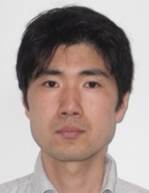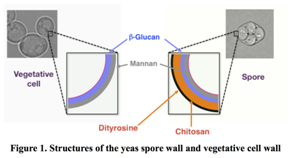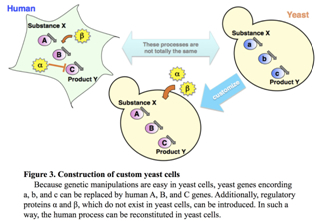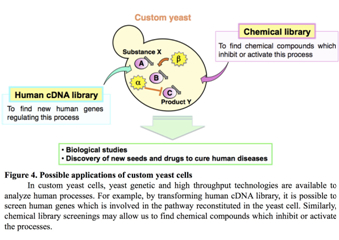
组长简介
姓名: 中西 秀树 (Hideki Nakanishi)
出生年月: 1973年9月28日
职称: 教授,博士生导师
研究领域: 酵母遗传学,分子生物学
人才称号: 江苏省双创人才
E-mail: hideki@jiangnan.edu.cn
教育背景:
1998-2001,日本东京农工大学,生物化学与生物技术,博士。
1996-1998,日本东京农工大学,生物化学与生物技术,硕士。
1992-1996,日本东京农工大学,生物化学与生物技术,本科
工作经历:
2011-现在,江南大学,生物工程学院,教授。
2007-2011,日本福岛县立医科大学,助理教授。
2006-2007,日本国立产业合研究所(AIST)糖锁研究中心,助理研究员。
2001-2006,美国纽约州立大学,博士后研究员。
2001-2001,日本产业技术综合研究所,博士后研究员。
研究队伍:
主要研究内容
I. Applied studies of yeast spores
Aim:
We are trying to understand unique properties of yeast spores and apply them to something useful or interesting.
Background:
The budding yeastSaccaromyces cerevisiaeforms spores under conditions of the absence of nitrogen and the presence of non-fermentable carbon sources. Yeast spores have several unique features which do not exist in vegetative cells.For example, spores contain unique structures in the spore wall. The spore wall consists of four layers composed (from the inside out) of β-glucan, mannoprotein, chitosan and dityrosine layers (Figure 1).β-glucan and mannoproteins are shared components of both the spore and vegetative cell walls, whereas the chitosan and dityrosine layers are structures unique to the spore wall.Compared to vegetative cells, yeast spores are more resistant to environmental challenges. The stress resistance properties of the spore are largely dependent on protective features of the outer two layers.

The spore wall is assembledde novoin a sequential manner such that chitosan layer formation is followed by dityrosine deposition (Figure 2). If the chitosan layer is absent or severely defective, the dityrosine layer is not assembled, though spores are viable even in the absence of the outer two layers. Thus, it is possible to expose several polymers to the spore surface by genetic manipulations.
On going projects:
Figure 1. Structures of the yeas spore wall and vegetative cell wall
Figure 2. Spore wall formation process and possible applications of spores
①Usage of yeast spores as micro particles
As mentioned above, spores can be made resemble chitosan or glucan particles(their size is 2~3 µm)by disrupting certain genes (Figure 2).β-glucanand chitosan particles are used for variety of purposes including oral vaccination and drug delivery platforms. Thus, we are testing whether spores are applied to these purposes.

②Production ofmicroencapsulated enzymes
Yeast spores can hold soluble proteins in the periplasmic space ofthe spore wall because its outer layers work as a diffusion barrier.Although the spore wall prevents diffusion of proteins, it is likely that smaller molecules such as sugars pass through it. Thus, spores can be used as microcapsules to incorporate soluble enzymes. For example, we have produced microcapsules includingα-galactosidase orD-xylose isomerase.
③Investigation of dityrosine assembly mechanism
The dityrosine layer is formed on the chitosan layer and provides strength to the spore wall. Thus, maybe, dityrosine is used as a novel material to modify chitosan.
II. The custom yeast project
Aim:
To reconstitute human biological processes in yeast cells by genetic manipulations so that yeast genetic and high throughput technologies are applied to analyze human processes.
Background:
Although S. cerevisiae is one of the best studied model organisms, yeast and human cells are not completely the same: human processes often have more complicated regulatorymechanisms. Thus, yeast is not always an ideal model to study human. However, since genetic manipulations are easy in yeast cells, it is possible to reconstitute human biological processes in yeast cells. Such “customized” yeast cells can be better models for human cell studies than wild-type yeast cells (Figure 3).

On going projects:
We are currently reconstituting human metabolic pathways, vesicle fusion mechanisms and so on. These processes are related to disorders such as diabetes, cancer and neurodegenerative diseases. For example, we replaced yeast ethanol fermentation pathway with human lactic acid fermentation. Custom yeast cells will be subjected to genetic and chemical screenings (Figure 4).

近年发表论文(2016-present)
SCI articles:
Corresponding author:
1) Bemena LD, Mukama O, Neiman AM, Li Z, Gao X-D* and Nakanishi H*. (2017) In vitro reconstitution of the yeast spore wall dityrosine layer to disclose the mechanism of its assembly. J Biol Chem. 2017 Sep 22;292(38):15880-15891. doi: 10.1074/jbc.
2) Bemena LD., Mukama O., Wang N., Gao X-D. and Nakanishi H*. (2017) Characterization of a yeast sporulation-specific P450 family protein, Dit2, using an in vitro assay to crosslink formyl tyrosine. J Biochem. Oct 9. doi: 10.1093/jb/mvx082.
3) Pan HP, Wang N, Tachikawa H, Gao X-D*, Nakanishi H*. (2017) Osw2 is required for proper assembly of glucan and/or mannan layers of the yeast spore wall. J Biochem. doi: 10.1093/jb
4) Pan HP, Wang N, Tachikawa H, Nakanishi H*and Gao X-D*. ß-1,6-glucan synthesis-associated genes are required for proper spore wall formation in Saccharomyces cerevisiae. Yeast.2017 Jul 21. doi: 10.1002/yea.3244. doi: 10.1002/yea.3244.
5) Nakanishi H*., Li F; Han B., Arai S and Gao X-D*., (2017) Yeast cells as an assay system for in vivo O-GlcNAc modification. BBA-general subjects, 2017 May; 1861(5 Pt A): 1159-1167. doi: 10.1016/j.bbagen.2017.03.002.
6) Li S-T., Wang N., Xu S., Yin J, Nakanishi H*., Dean N, Gao X-D*. (2017) Quantitative study of yeast Alg1 beta-1, 4 mannosyltransferase activity, a key enzyme involved in protein N-glycosylation. BBA-general subjects, 2017 Jan;1861(1 Pt A): 2934-2941. doi: 10.1016/j.bbagen.2016.09.023.
7) Kong J., Li Z., Zhang H., Gao X-D* and Nakanishi H*. (2017) Production of encapsulated creatinase using yeast spores, Bioengineered. 2017 Jul 4;8(4):411-419. doi: 10.1080/21655979.2016.1241926.
8) Kong J., Li Z., Zhang H., Gao X-D* and Nakanishi H*. (2017) Consecutive hydrolysis of creatinine using creatininase and creatinase encapsulated in Saccharomyces cerevisiae spores, Biotechnology Letters, 2017 Feb;39(2):261-267. DOI: 10.1007/s10529-016-2234-9.
9) Feng S. Zhang H. Yan T. Huang D. Zhi C. (2016) Nakanishi H* and Gao X-D. Folate-conjugated boron nitride nanospheres for targeted delivery of anticancer drugs. International Journal of Nanomedicine 11: 4573–4582
Coauthor:
1) Li S-T, Wang N, Xu X-X, Fujita M,Nakanishi H, Kitajima T, Dean N* and Gao X-D*. (2017) Alternative routes for synthesis of N-linked glycans by the Alg2 mannosyltransferase. FASEB J. 2017 Dec 22. pii: fj.201701267R. doi: 10.1096/fj.
2) Nakamura TS, Numajiri Y, Okumura Y, Hidaka J, Tanaka T, Inoue I, Suda Y, Takahashi T, Nakanishi H, Gao X-D, Neiman AM, Tachikawa H. (2017) Dynamic localization of a yeast development-specific PP1 complex during prospore membrane formation is dependent on multiple localization signals and complex formation. Mol Biol Cell. 2017 Oct 18. pii: mbc.E17-08-0521. doi: 10.1091/mbc.
3) Xu S; Zhang G-Y; Zhang H; Kitajima T; Nakanishi H; Gao X-D*. (2016) Effects of Rho1, a small GTPase on the production of recombinant glycoproteins in Saccharomyces cerevisiae. Microb Cell Fact., 2016 Oct 21;15(1):179. doi:10.1186/s12934-016-0575-
代表性研究成果
SCI articles:
1) Bemena LD, Mukama O, Neiman AM, Li Z, Gao X-D* and Nakanishi H*.In vitro reconstitution of the yeast spore wall dityrosine layer to disclose the mechanism of its assembly. J Biol Chem. 2017 Sep 22;292(38):15880-15891. doi: 10.1074/jbc.
2) Pan HP, Wang N, Tachikawa H, Gao X-D*and Nakanishi H*. (2017) Osw2 is required for proper assembly of glucan and/or mannan layers of the yeast spore wall. J Biochem. doi: 10.1093/jb/mvx082.
3) Nakanishi H*., Li F; Han B., Arai S. and Gao X-D*, (2017) Yeast cells as an assay system for in vivo O-GlcNAc modification. BBA-general subjects, 2017 May; 1861(5 Pt A): 1159-1167. doi: 10.1016/j.bbagen.2017.03.002.
4) Feng S. Zhang H. Yan T. Huang D. Zhi C. (2016) Nakanishi H* and Gao X-D. Folate-conjugated boron nitride nanospheres for targeted delivery of anticancer drugs. International Journal of Nanomedicine 11: 4573–4582
5) Mohamed LA, Tachikawa H, Gao X-D* and Nakanishi H*. (2015) Yeast cell-based analysis of human lactate dehydrogenase isoforms. J Biochem. 34(6), 349-357
6) Zhang H, Tachikawa H, Gao X-D* and Nakanishi H*. (2014) Applied uses of yeast spores as chitosan beads. Appl Environ Microb., 80(16): 5098-105.
7) Shi L, Li Z, Tachikawa H, Gao X* and Nakanishi H*. (2014) Microencapsulation of enzymes using yeast spores. Appl Environ Microb., 80(15): 4502-4510.
8) Nakanishi H, Suda Y and Neiman AM*. (2007) Erv14 family cargo receptors are necessary for ER exit during sporulation in Saccharomyces cerevisiae. J Cell Sci., 120: 908-916.
9) Nakanishi H, Morishita M, Schwartz C, Coluccio A, Engebrecht JA and Neiman AM*. (2006) Phospholipase D and the SNARE Sso1p are necessary for vesicle fusion during sporulation in yeast. J Cell Sci., 119, 1406-1415.
10) Nakanishi H, de los Santos P and Neiman AM*. (2004) Positive and negative regulation of a SNARE protein by control of intracellular localization. Mol Biol Cell., 15: 1802-1815.
专利:
中西秀树,高晓冬,张海妮,李子杰.一种以酿酒酵母孢子为载体的新型固定化酶的制备方法. 2013.9,中国,ZL201310422568.8
学术奖励
2013年获选江苏省“高层次创新创业人才引进计划”(双创)
2012年获选无锡市“社会事业领军人才计划”

